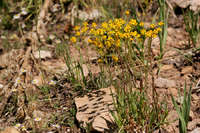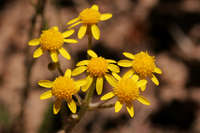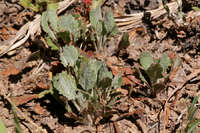Perennials, 10-50+ cm; fibrous-rooted (caudices weak to stout, horizontal to suberect). Stems 1 or 2-5, clustered, usually glabrous, sometimes sparsely floccose-tomentose proximally and in leaf axils. Basal leaves (and proximal cauline, relatively thick and turgid) petiolate; blades spatulate to oblanceolate, or ovate to orbiculate, 20-40+ × 10-30+ mm, bases tapering to abruptly contracted or subcordate, margins entire, crenate, dentate, or weakly lobulate (faces usually glabrous, sometimes hairy). Cauline leaves gradually to abruptly reduced (± petiolate or sessile; entire or subentire). Heads 2-20+ in loose, corymbiform or subumbelliform arrays. Peduncles bracteate, glabrous or sparsely tomentose. Calyculi conspicuous. Phyllaries (8-)13 or 21, green (tips sometimes cyanic), 4-7+ mm, glabrous. Ray florets 8 or 13; corolla laminae 5-10 mm. Disc florets 35-60+; corolla tubes 2-4 mm, limbs 2.5-4 mm. Cypselae 1-2.5 mm, glabrous; pappi 3-6 mm. 2n = 46, 92.
Flowering late May-late Aug. Forests, open meadows, valleys, dry to damp and loamy soils; 1000-3400 m; Alta., B.C., N.W.T., Sask., Yukon; Calif., Colo., Idaho, Mont., Nev., N.Mex., Oreg., Utah, Wash., Wyo.
Packera streptanthifolia is widespread and variable throughout the Western Cordillera. It includes weakly defined phases that have been treated as distinct species or as varieties. Characteristics used to delimit those taxa often overlap and are difficult to score; some 'phases' grade into each other. Northern populations are sometimes segregated as a distinct taxon (e.g., Senecio streptanthifolia var. borealis; J. F. Bain 1988).






